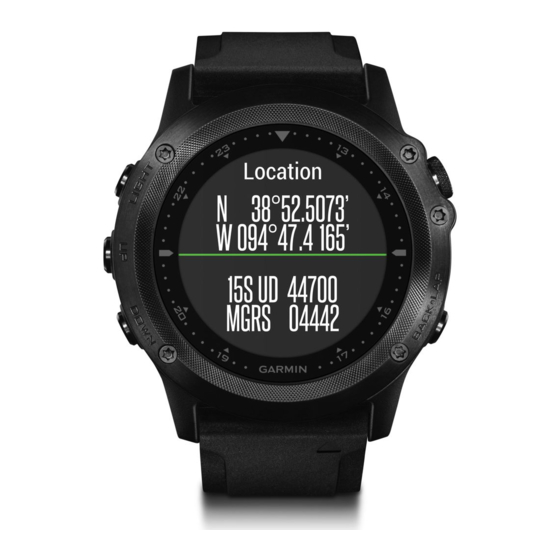Garmin tactix Bravo Owner's Manual - Page 27
Browse online or download pdf Owner's Manual for Watch Garmin tactix Bravo. Garmin tactix Bravo 34 pages.

harsh chemicals. Prolonged exposure to these substances can
damage the case.
Avoid pressing the keys under water.
Avoid extreme shock and harsh treatment, because it can
degrade the life of the product.
Do not store the device where prolonged exposure to extreme
temperatures can occur, because it can cause permanent
damage.
Cleaning the Device
Even small amounts of sweat or moisture can cause corrosion
of the electrical contacts when connected to a charger.
Corrosion can prevent charging and data transfer.
1
Wipe the device using a cloth dampened with a mild
detergent solution.
2
Wipe it dry.
After cleaning, allow the device to dry completely.
Heart Rate Monitor Care Instructions
Caring for the Heart Rate Monitor
A buildup of sweat and salt on the strap can decrease the ability
of the heart rate monitor to report accurate data.
• Rinse the heart rate monitor after every use.
• Hand wash the heart rate monitor after every seven uses,
using a tiny amount of mild detergent, such as dishwashing
liquid.
NOTE: Using too much detergent may damage the heart rate
monitor.
• Do not put the heart rate monitor in a washing machine or
dryer.
• When drying the heart rate monitor, hang it up or lay it flat.
User Replaceable Batteries
Do not use a sharp object to remove batteries.
Keep the battery away from children.
Never put batteries in mouth. If swallowed, contact your
physician or local poison control center.
Replaceable coin cell batteries may contain perchlorate
material. Special handling may apply. See
/hazardouswaste/perchlorate.
Contact your local waste disposal department to properly
recycle the batteries.
Replacing the Heart Rate Monitor Battery
1
Remove the sleeve
from the heart rate monitor module.
2
Use a small Phillips (00) screwdriver to remove the four
screws on the front of the module.
3
Remove the cover and battery.
Appendix
NOTICE
NOTICE
WARNING
www.dtsc.ca.gov
CAUTION
4
Wait 30 seconds.
5
Insert the new battery under the two plastic tabs
positive side facing up.
NOTE: Do not damage or lose the O-ring gasket.
The O-ring gasket should remain around the outside of the
raised plastic ring.
6
Replace the front cover and the four screws.
Observe the orientation of the front cover. The raised screw
should fit in the matching raised screw hole on the front
cover.
NOTE: Do not overtighten.
7
Replace the sleeve.
After you replace the heart rate monitor battery, you may need
to pair it with the device again.
Appendix
Data Fields
%FTP: The current power output as a percentage of functional
threshold power.
%HRR: The percentage of heart rate reserve (maximum heart
rate minus resting heart rate).
10s Avg. Power: The 10-second moving average of power
output.
10s Avg Balance: The 10-second moving average of the left/
right power balance.
24-Hour Max.: The maximum temperature recorded in the last
24 hours.
24-Hour Min.: The minimum temperature recorded in the last
24 hours.
30s Avg. Power: The 30-second moving average of power
output.
30s Avg Balance: The 30-second moving average of the left/
right power balance.
3s Avg. Balance: The three-second moving average of the left/
right power balance.
3s Avg. Power: The 3-second moving average of power output.
500m Pace: The current swimming pace per 500 meters.
Ambient Press.: The uncalibrated ambient pressure.
Average HR: The average heart rate for the current activity.
Average Pace: The average pace for the current activity.
Average Power: The average power output for the current
activity.
Average SWOLF: The average swolf score for the current
activity. Your swolf score is the sum of the time for one length
plus the number of strokes for that length
Terminology, page
4). In open water swimming, 25 meters is
used to calculate your swolf score.
Avg. %HRR: The average percentage of heart rate reserve
(maximum heart rate minus resting heart rate) for the current
activity.
with the
(Swim
23
